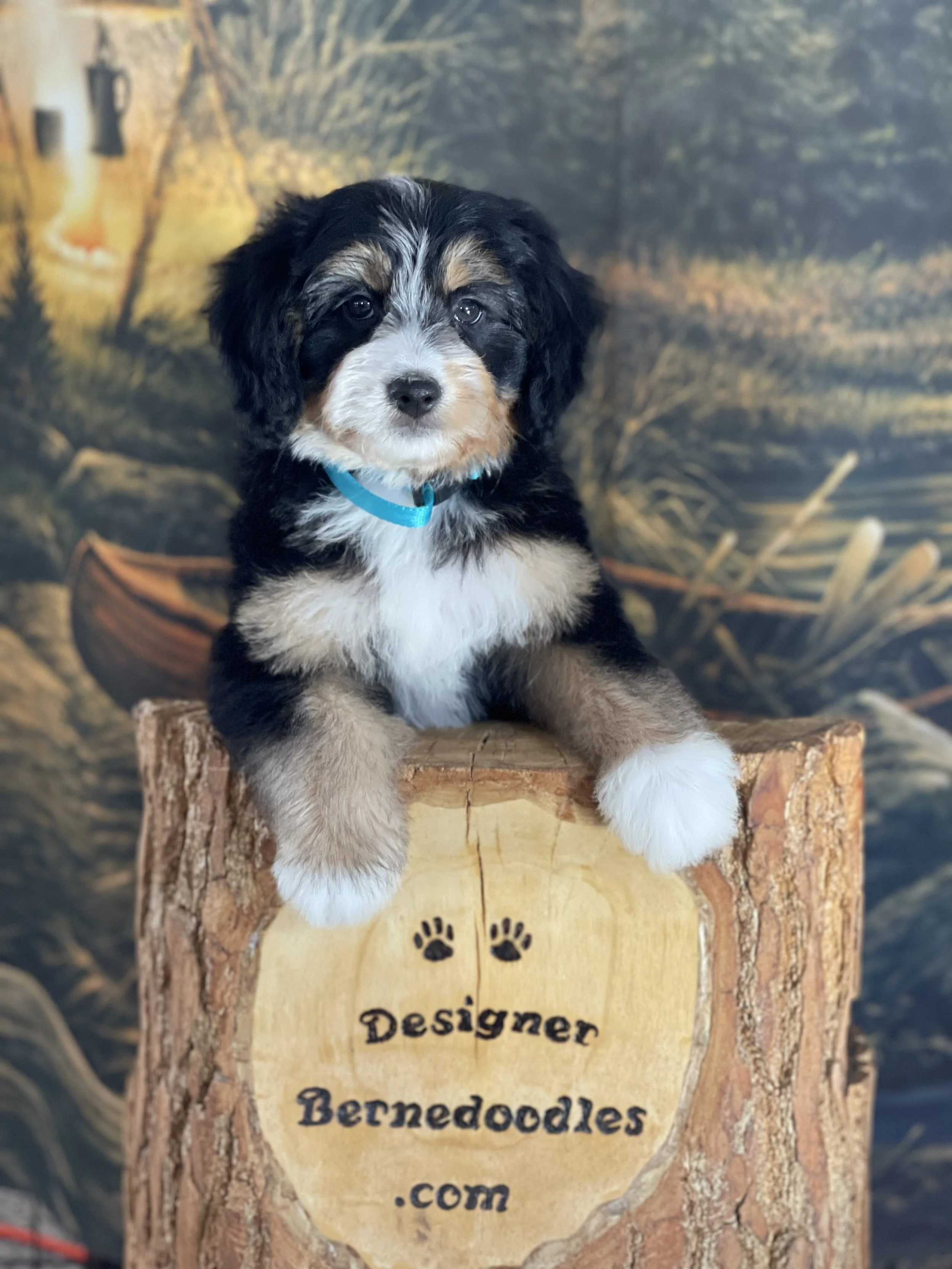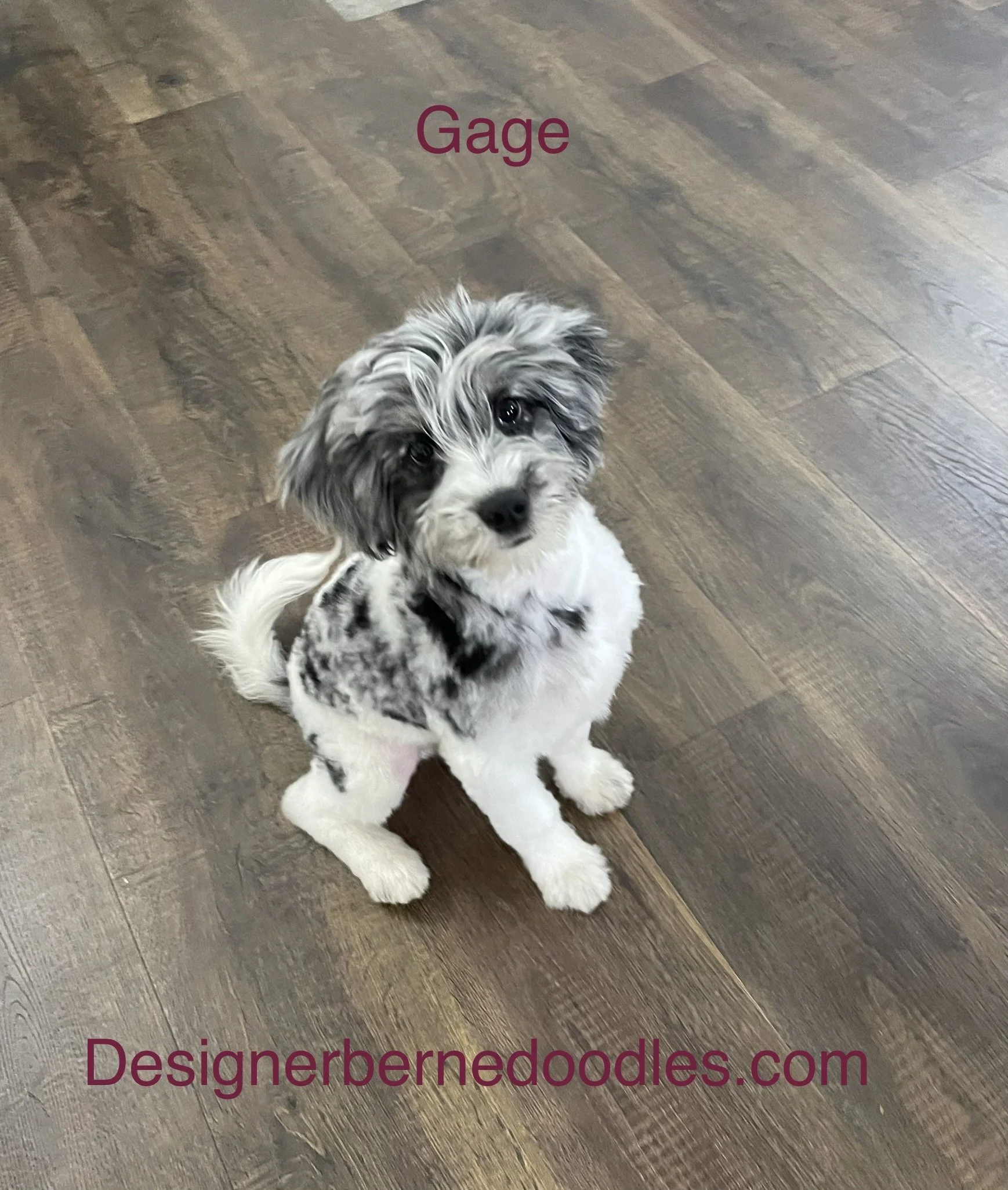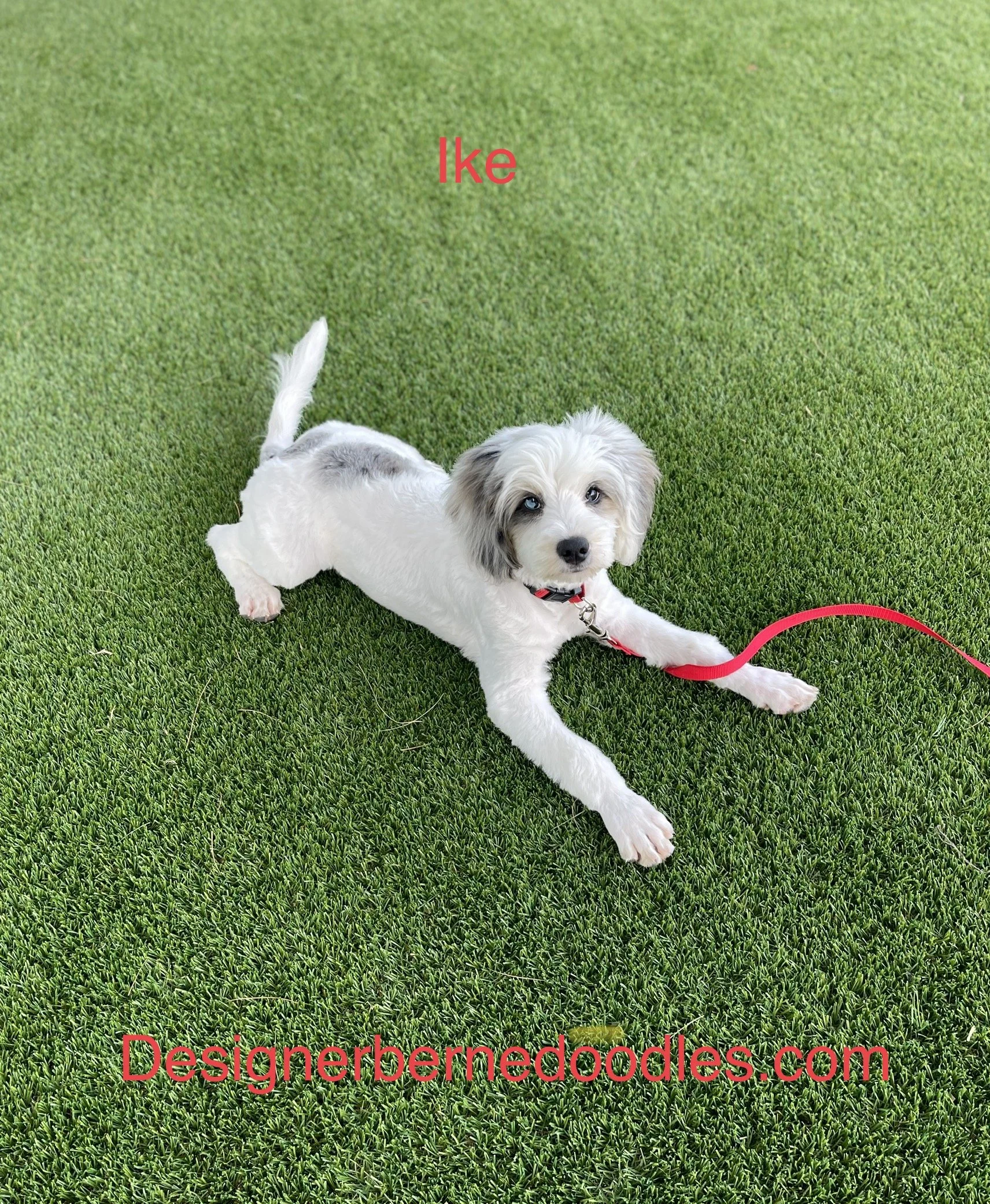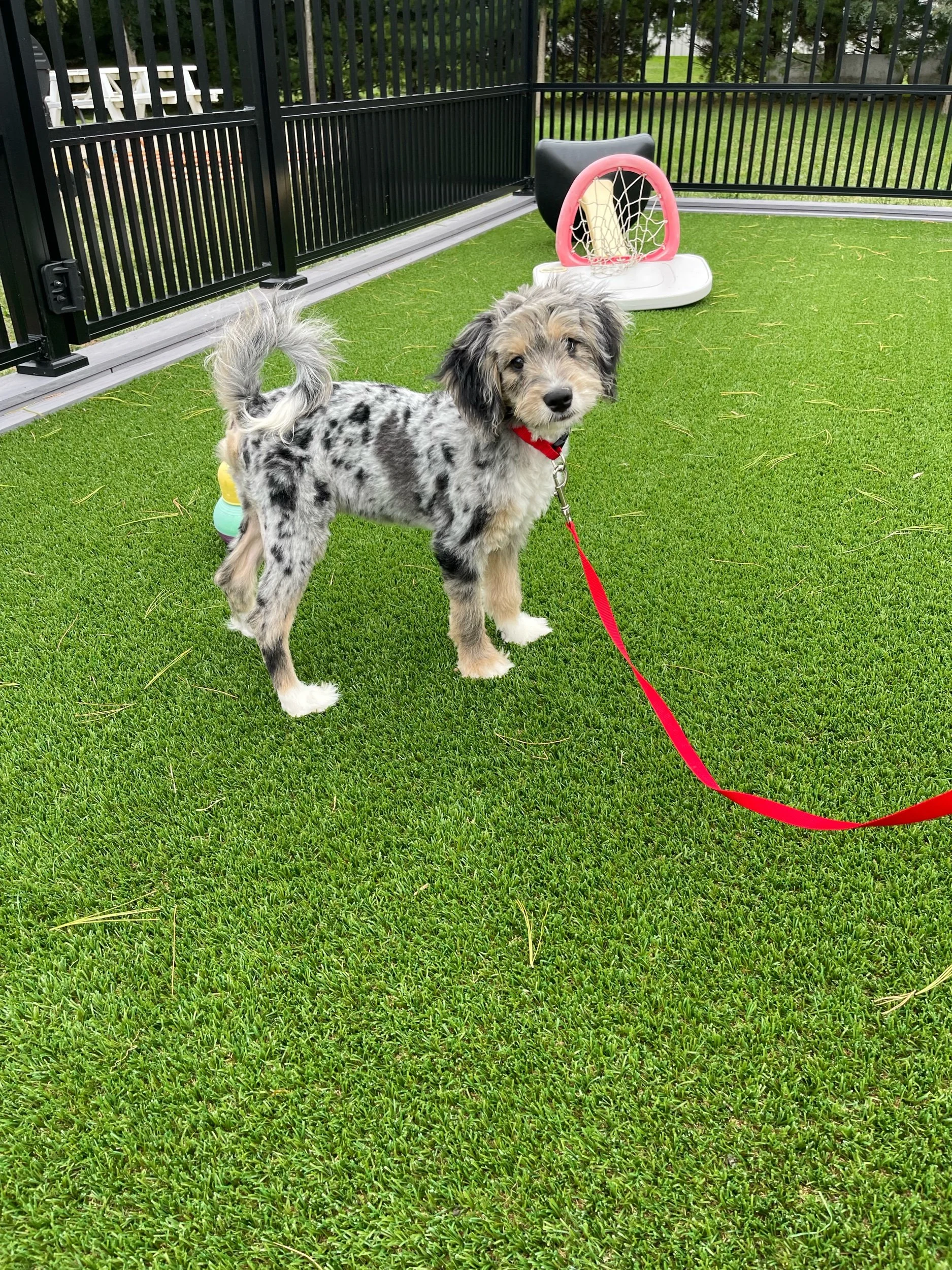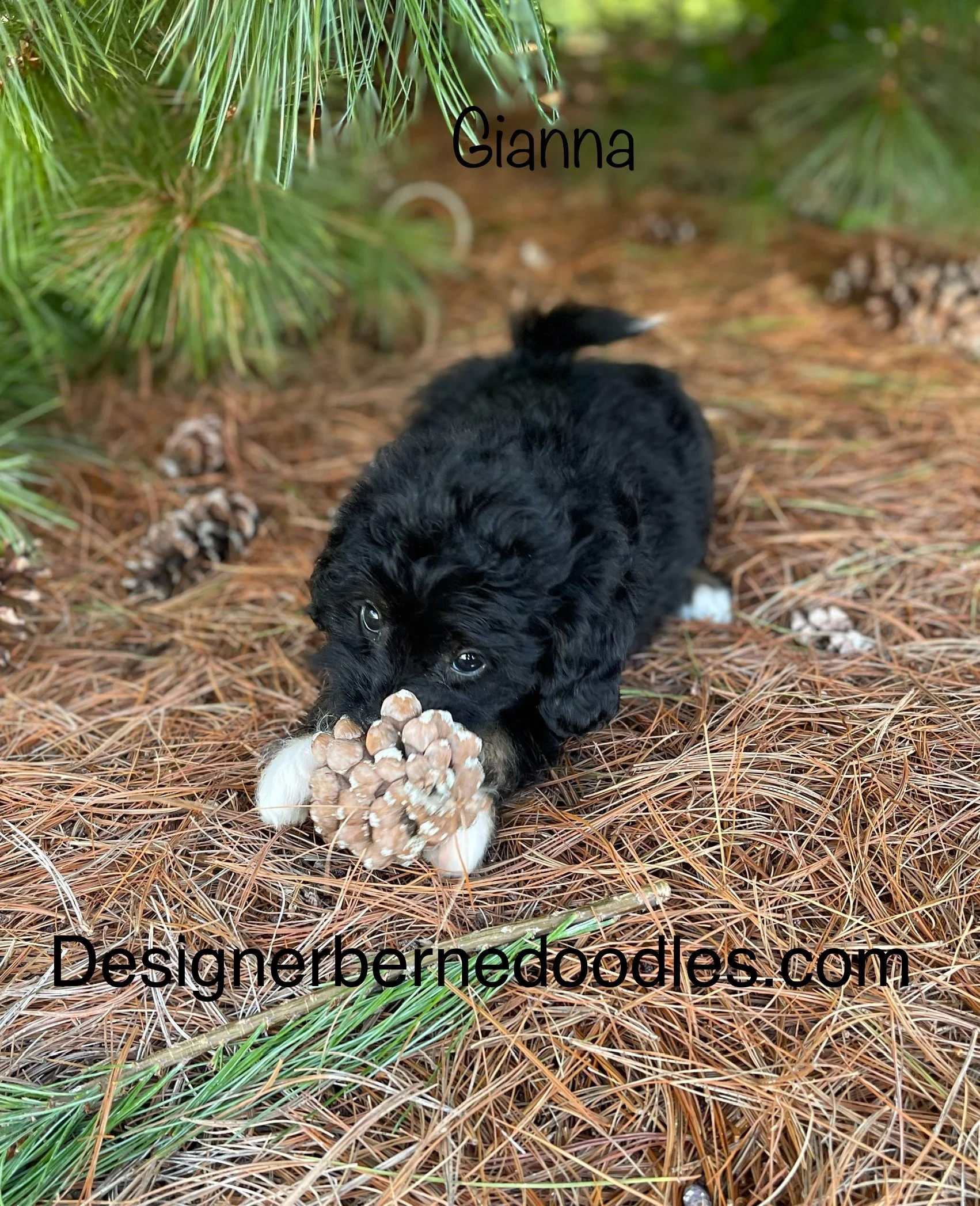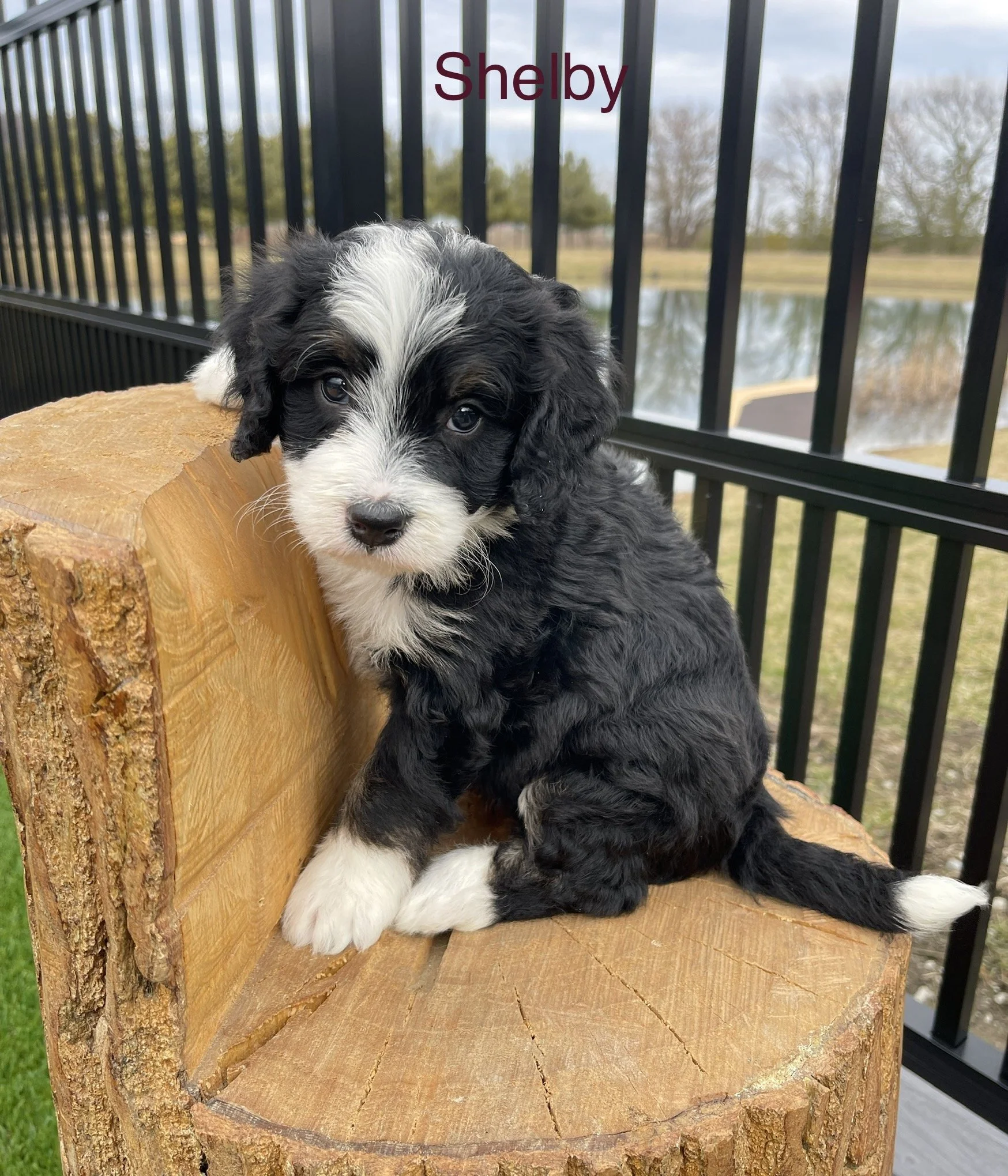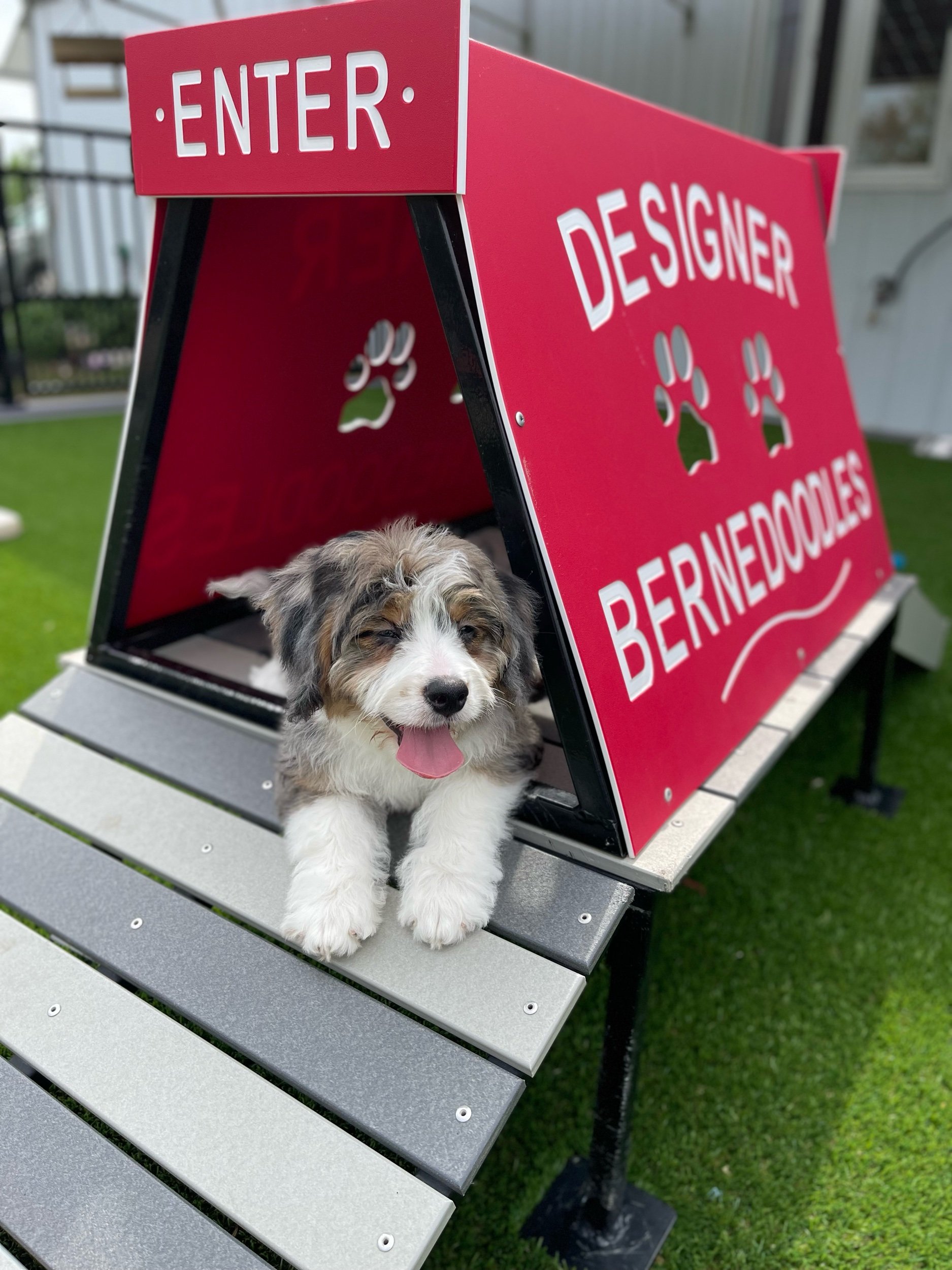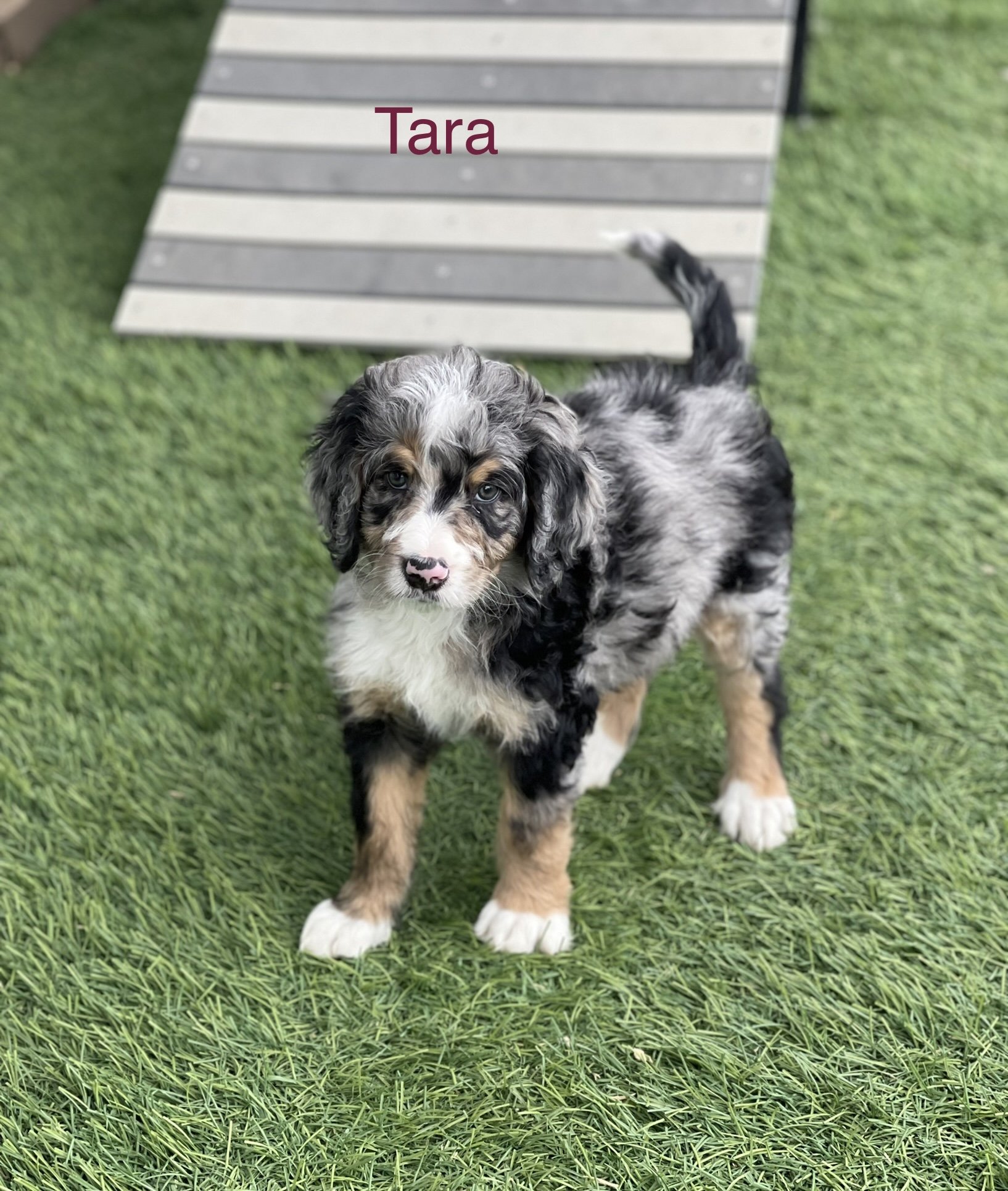Bernedoodle Coat Colors
When you're considering a new Bernedoodle puppy, the variety of coat colors can be both intriguing and overwhelming. Each color, from the classic solid shades to more intricate patterns like tri-color and merle, has its own appeal and significance. You might find yourself drawn to the striking contrast of a bi-color or the unique marbling of a merle coat. However, as you explore these options, it's crucial to remember that aesthetics are only part of the equation. What other factors should influence your choice when selecting the perfect Bernedoodle?
Key Takeaways
Bernedoodles come in various colors including tri-color, solid, bi-color, merle, phantom, sable, and brindle.
Common solid colors include black, brown, cream, apricot, and silver, while bi-color variations feature combinations like black and white.
Tri-color coats showcase black, white, and rust-brown, reflecting their Bernese Mountain Dog heritage.
Merle coats have marbled effects with diluted colors, while sable and brindle patterns add unique visual appeal.
Understanding color genetics, including the fading gene, is crucial for anticipating potential color changes in puppies.
Overview of Bernedoodle Colors
When it comes to Bernedoodle colors, you'll find an impressive variety that reflects their mixed heritage. These dogs can showcase a wide range of coat colors and patterns, making each one unique. The most popular among these is the traditional tri-color, which features a striking black base adorned with white and rust-brown markings reminiscent of the Bernese Mountain Dog.
Additionally, you might encounter Bernedoodles with merle patterns. These coats display a mesmerizing marbled effect, blending diluted colors that can be visually captivating. However, it's crucial to note that careful breeding practices are essential to ensure the health of merle puppies.
Aside from these patterns, Bernedoodles can also present solid colors like black, brown, cream, apricot, and silver for those who prefer a simpler aesthetic.
The variety in Bernedoodle coat color largely stems from the genetic traits inherited from their parent breeds, which play a significant role in determining their appearance. Genetic testing can help prospective owners understand the colors and patterns they might expect in their future furry friend.
Solid Coat Colors
While Bernedoodles are often celebrated for their stunning patterns, solid coat colors offer a sleek and elegant alternative that many owners appreciate. Among the solid colors, you'll find striking shades like jet black, chocolate brown, cream, apricot, and silver. Each color showcases the diverse genetic influence from both parent breeds.
Solid black Bernedoodles are particularly eye-catching, characterized by their uniform color that lends a classic look. If you prefer a richer hue, chocolate brown Bernedoodles possess a deep, luxurious coat that often matches their nose, adding to their charm.
For those who enjoy softer tones, cream and apricot options range from light to darker shades, providing a warm, inviting appearance.
Regardless of the solid color you choose, Bernedoodles typically feature a wavy or curly coat that's low to non-shedding, making them a great option for allergy sufferers.
These solid colors not only highlight the unique beauty of Bernedoodles but also allow you to express your personal style when selecting your furry companion. Whether you lean toward a deep black or a soft cream, each solid color brings its own unique appeal to your Bernedoodle.
Bi-Color Variations
Bi-color Bernedoodles offer a striking blend of two distinct colors, creating a captivating visual appeal that stands out. These dogs typically feature less defined color placements than those with phantom coats, leading to a delightful variety in their appearances.
You'll often find large patches of a secondary color adorning different parts of the body, which makes each dog truly unique.
One of the most popular bi-color combinations is black and white, where the solid black base coat showcases prominent white markings, resulting in a classic and sophisticated look. However, the secondary color can vary widely, leading to unique combinations like chocolate and cream or apricot and white.
This versatility allows you to choose a Bernedoodle that not only fits your style but also reflects your personality.
Bi-color patterns are less common among multigen Bernedoodles, making them a distinctive choice for those seeking a standout companion.
If you're drawn to the idea of a dog that's not only charming but also visually striking, a bi-color Bernedoodle might be the perfect fit for you.
Tri-Color Patterns
Emphasizing their striking appearance, tri-color Bernedoodles showcase a captivating blend of colors that pays homage to their Bernese Mountain Dog lineage. The traditional tri-color pattern features a rich black base, adorned with distinct white markings and rust-brown accents. This classic combination is the most sought-after among Bernedoodle enthusiasts, celebrated for its vibrant and eye-catching look.
You might also encounter a brown tri-color variation, which presents a warm brown base while retaining those characteristic white and rust-brown markings. This twist on the classic tri-color coat offers a unique option for those looking for something different.
Additionally, some tri-color coats appear in phantom variations, where the white is less prominent, allowing the contrasting colors to take center stage.
If you're considering a tri-color Bernedoodle, you'll appreciate the vivid red and white color pattern, showcasing bright red fur with prominent white markings. This rare combination is increasingly desirable and adds another layer of charm to the already diverse traits found in Bernedoodles.
Whether you prefer traditional or more unique variants, the tri-color patterns truly enhance the beauty of these lovable dogs.
Merle Coat Description
Have you ever seen a Bernedoodle with a merle coat? If you have, you know how stunning these dogs can be! The merle coat is characterized by patches or streaks of diluted colors, creating a unique marbled effect on the base coat, which is often black or brown. This beautiful coat pattern features shades like gray, blue, or red, making each Bernedoodle's appearance distinct.
The combination of the merle coat with other coat patterns, such as tri-color or phantom variations, enhances the visual diversity of these dogs.
However, it's important to remember that responsible breeding practices are crucial when it comes to merle Bernedoodles. Breeders need to manage the merle gene carefully to avoid health issues like deafness or blindness in the puppies.
Only one copy of the merle gene is present in all merle dogs, which plays a key role in ensuring the health and safety of the puppies produced.
If you're considering a Bernedoodle with a merle coat, you'll not only be getting a gorgeous companion, but also one that showcases the fascinating genetics behind these unique coats.
Phantom Coat Characteristics
When exploring the captivating world of Bernedoodles, the phantom coat stands out with its striking two-tone pattern. This coat typically features a primary color—often black—paired with a contrasting secondary color that highlights specific areas like the eyebrows, cheeks, and legs. You might see common secondary colors such as brown, apricot, cream, silver, and blue, which all contribute to its distinctive coloration.
Phantom Bernedoodles can also have variations in their coat patterns. Non-merle phantom coats boast solid markings, while those with merle patterns display unique mottled effects that enhance their visual appeal. This captivating combination of colors is a major reason why many prospective owners seek out phantom Bernedoodles; their striking appearance sets them apart from other variations.
To keep that beautiful phantom coat looking its best, regular grooming is essential. Like other Bernedoodle variations, they require consistent care to maintain their healthy and appealing look.
With their eye-catching coloration and charming personality, phantom Bernedoodles are sure to capture your heart!
Sable and Brindle Coats
The allure of sable and brindle coats in Bernedoodles adds a unique charm to these already captivating dogs. Sable Bernedoodles showcase a stunning coat pattern that ranges from light cream to dark brown, with individual strands exhibiting multiple shades and darker tips on areas like the ears, tail, and back.
As these pups mature, their sable coats often lighten, creating a dynamic and evolving appearance that stands out.
On the other hand, brindle coats bring a striking tiger-striped pattern that draws the eye. Typically featuring a base color such as brown or gold, these coats have darker stripes that create a visually captivating contrast, appealing to many dog owners.
Both sable and brindle coats are less common in Bernedoodles compared to traditional tri-color and solid coats, making them unique choices for prospective owners.
If you're considering a Bernedoodle, opting for a sable or brindle coat can offer you a distinctive look that sets your dog apart from the crowd.
With their beautiful patterns and colors, these Bernedoodles not only turn heads but also showcase the diversity and charm inherent in the breed.
Parti Color Explained
If you're looking for a truly distinctive look in a Bernedoodle, consider the captivating parti color pattern. This striking design features a predominantly white coat with large patches of other colors like black, brown, or apricot. To qualify as a parti, the coat must have over 50% white in its overall color distribution, making it a unique choice for dog lovers who want something different.
The distribution of patches in a parti-colored Bernedoodle can vary significantly. Some may have their patches evenly spread, while others might display them sporadically across their body, creating an individual expression of color. This variability adds to the charm of these dogs, as no two parti-patterned Bernedoodles are exactly alike.
It's worth noting that parti patterns are less common in multigen Bernedoodles, which enhances their appeal. If you want a pup that stands out in a crowd, the parti color pattern is an excellent option.
These dogs not only boast a beautiful appearance but also showcase the diverse genetics of their parent breeds, making them a delightful addition to any family.
Color Genetics in Bernedoodles
Understanding color genetics in Bernedoodles is crucial for anyone looking to predict their future pup's appearance. The coat colors of Bernedoodles stem from the genetic traits inherited from their parent breeds, the Bernese Mountain Dog and Poodle. Poodles contribute a broader range of colors and patterns, allowing for unique combinations like traditional tricolor and merle patterns.
Genetic testing can help you anticipate the potential color outcomes in Bernedoodle litters. By analyzing the lineage of the parent dogs, you can gain insights into what colors might appear in the puppies.
It's also important to note that the fading gene, often found in Poodles, can lead to color changes in Bernedoodle puppies between 6 to 10 months of age, especially in darker coats.
When it comes to the merle pattern, it occurs with one copy of the merle gene, creating a marbled effect. However, breeding two merle dogs is discouraged due to health risks for the offspring.
Choosing the Right Color
Choosing the right color for your Bernedoodle can be an exciting yet challenging experience given the wide array of options available. With striking coat colors like black, white, tan, and variations like the traditional tri-color or merle, you have plenty to consider.
Start by reflecting on your personal aesthetic preferences, as each combination brings its unique charm and markings.
It's crucial to research the genetic background of the puppy's parents. Understanding their lineage can help you anticipate the potential color variations and ensure the coat pattern you desire is achievable.
Keep in mind that while color is important, prioritizing the health and temperament of the puppy should come first. There are no health differences associated with coat colors, and ethical breeders focus on overall well-being.
Be prepared for the possibility of color changes, especially due to the fading gene inherited from the Poodle lineage, which can alter your Bernedoodle's coat between 6 to 10 months of age.
Consulting reputable breeders can provide valuable insights into the availability of specific colors and help set realistic expectations about your future pup's coat type.
Conclusion
When choosing a Bernedoodle, remember that each coat color and pattern brings its own charm. Whether you're drawn to the striking tri-color or the unique merle, prioritize your pup's health and temperament over aesthetics. The right color for you will reflect your personal style, but the bond you'll build with your Bernedoodle is what truly matters. Embrace the journey, and enjoy finding the perfect furry friend that fits your family!

